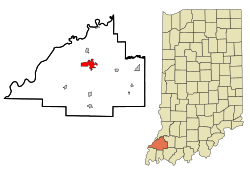Princeton, Indiana
| Princeton, Indiana | |
|---|---|
| City | |

Southern and western sides of Princeton's best-known landmark, the 1884 Gibson County Courthouse
|
|
| Nickname(s): The Heart of Southwestern Indiana |
|
| Motto: "Creating A World Class Community" | |
 Location in the state of Indiana |
|
| Coordinates: 38°21′13″N 87°34′14″W / 38.35361°N 87.57056°WCoordinates: 38°21′13″N 87°34′14″W / 38.35361°N 87.57056°W | |
| Country |
|
| State |
|
| County | Gibson |
| Township | Patoka |
| Settled | 1814 |
| Named for | William Prince |
| Government | |
| • Mayor | Brad Schmitt (R) |
| Area | |
| • Total | 5.08 sq mi (13.16 km2) |
| • Land | 5.07 sq mi (13.13 km2) |
| • Water | 0.01 sq mi (0.03 km2) 0.20% |
| Elevation | 430 ft (121 m) |
| Population (2010) | |
| • Total | 8,644 |
| • Estimate (2014) | 8,608 |
| • Density | 1,704.9/sq mi (658.3/km2) |
| Time zone | CST (UTC−6) |
| • Summer (DST) | CDT (UTC−5) |
| ZIP code | 47670 |
| Area code(s) | 812, 930 |
| FIPS code | 18-62046 |
| GNIS feature ID | 0452074 |
| U.S. Highways | |
| Major State Roads |
|
| Website | http://princeton-indiana.com/ |
Princeton is a city in Patoka Township, Gibson County, Indiana, United States. The population was 8,644 at the 2010 census, and it is part of the greater Evansville, Indiana, Metropolitan Area. The city is the county seat of and the largest city in Gibson County.
In 1800 the Indiana Territory was created with Vincennes (Knox County) as its capital. The rich farmlands in the southwest of the territory with access to the Ohio River attracted many pioneers and settlers to the area, one of whom was an Irish immigrant named William Prince. Born in 1772, he immigrated to America 22 years later. He would become a Gibson County Commissioner and the namesake for the county seat of Princeton.
The year 1813 saw the move of the territorial capital east from Vincennes to Corydon and the creation of Gibson County. Gibson had previously been part of the vast Knox County which covered all the land of southwestern Indiana, bordered by the Wabash and Ohio Rivers. By early 1814, settlers to this area were asking for a "seat of justice," or county seat. Captain William Prince was one of four commissioners who located the seat at the half-way stand on the Evansville and Vincennes stage line. By drawing of lots, commissioners decided to name the town after Captain Prince.
The iconic symbol of Princeton is the Gibson County Courthouse, a structure built in the Second Empire style. It has been featured as a collectible figurine by the Department 56 Original Snow Village. A post office was established in Princeton as early as 1816. The local newspaper, the Princeton Daily Clarion, was first published in 1846. Lyles Station, a small community just west of Princeton, was founded by freed Tennessee slave Joshua Lyles in 1849. It served as a haven for runaway slaves who braved the Ohio River on a northern trek towards freedom.
...
Wikipedia
